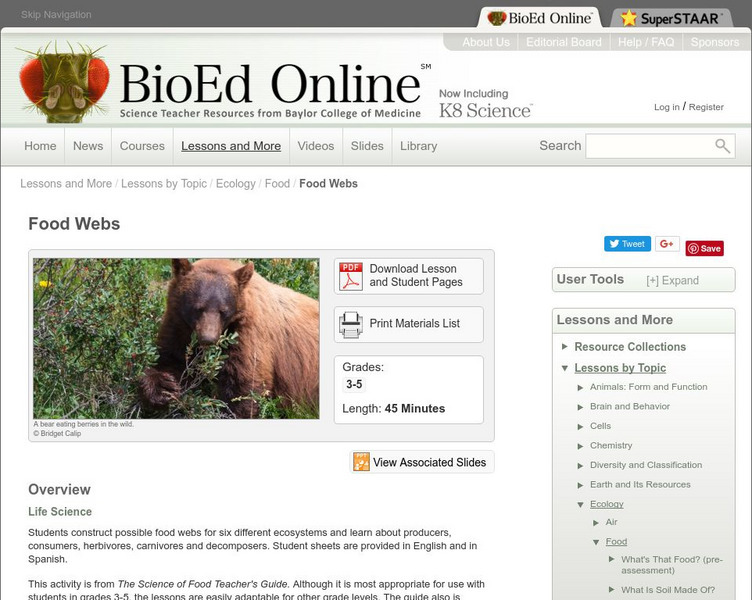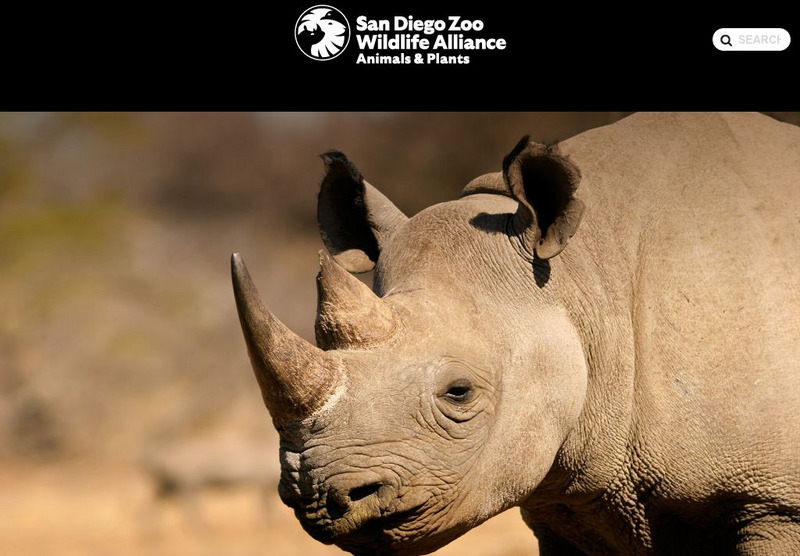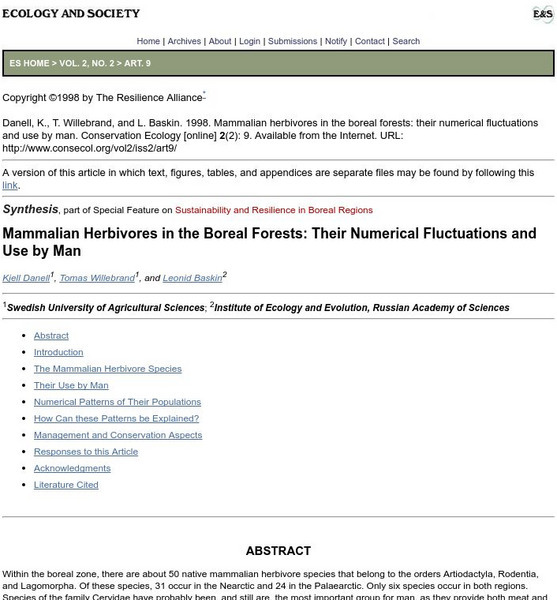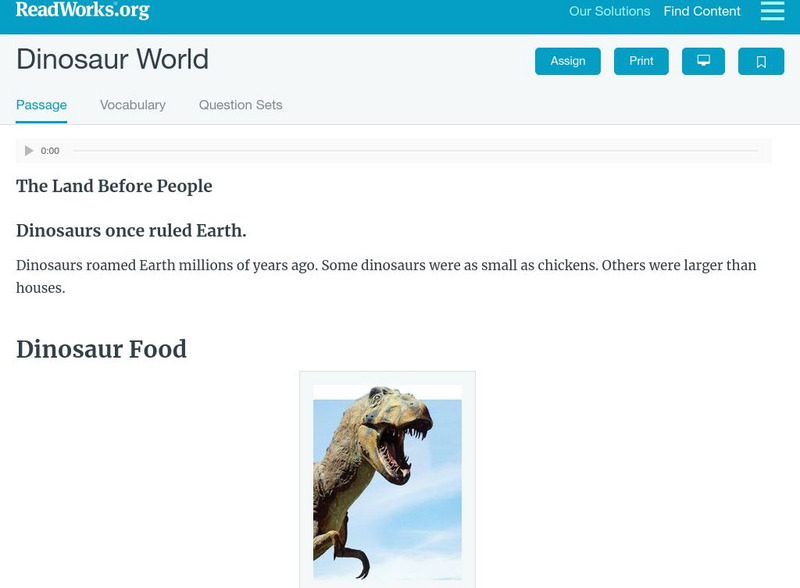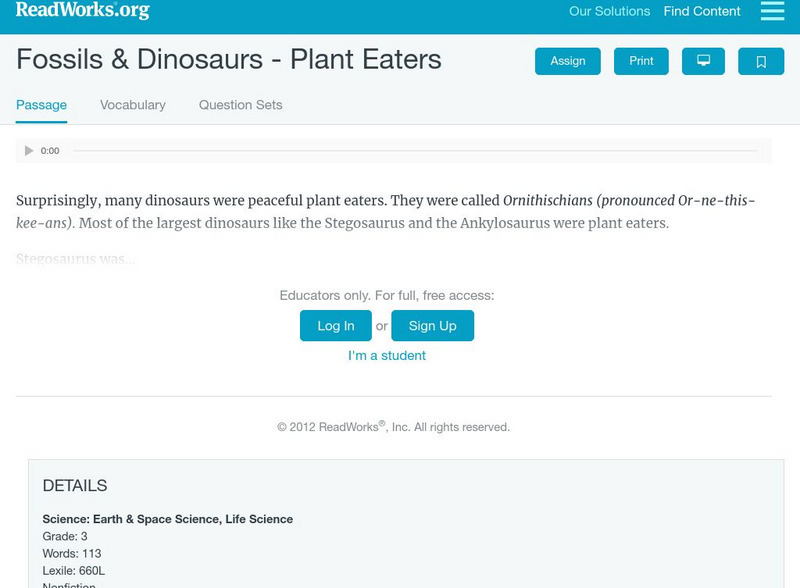Curated OER
Adopt-A-Dinosaur Fact Sheet
In this science worksheet, students complete the blank fact sheet by selecting a dinosaur of their choice. They name its family, size, location, time period found, foods ate, and some amazing facts about it.
Curated OER
Ecology Test Word Search
In this earth science worksheet, students locate and identify various vocabulary terms related to earth science. There are 19 words located in the puzzle.
Curated OER
Food Chain
In this science worksheet, students match the words given in the first column with the correct definition found in the second column. There are six vocabulary terms to define.
Curated OER
What Does It Eat?
Students, working in research teams, investigate the eating habits of crickets. They collect and record data and compare their methods and results with other groups by making tables or graphs. They sumarize their findings with posters or...
Curated OER
What Animals Eat
First graders organize animals according to what they eat. They compare the teeth of plant eaters and meat eaters.
Scholastic
Scholastic Explorers: Endangered Ecosystems
A great site with something for all grades. Do research on rainforests, follow field research on animals in Latin America, and show what you know through interactive assessments. Lots to see on this site which is a collaboration of...
BioEd Online
Bio Ed Online: Food Webs
Students construct possible food webs for six different ecosystems as they learn about the roles of producers, consumers, herbivores, carnivores and decomposers.
San Diego Zoo Global
San Diego Zoo: Rhinoceros
This resource provides detailed information about the rhinoceros, as well as several pictures and audio clips.
San Diego Zoo Global
San Diego Zoo: Antelope
This resource provides extensive information about the antelope, including several photos. [1:08]
San Diego Zoo Global
San Diego Zoo: Koalas
This resource presents detailed information about the koala, including several photos and a video clip. [0:12]
Smithsonian Institution
Smithsonian Environmental Research Center: Forces of Change: Weaving the Web
The students will become the food web in this fun interactive classroom activity. Detailed instructions, background information, guiding questions, and activity worksheets are provided.
African Wildlife Foundation
African Wildlife Foundation: Zebra
Resource takes an exploratory look at the zebra. Content includes information on this animal's physical characteristics, habitat, behavior, diet, care of the young, predators, and more. Recent news about zebras is also included.
San Diego Zoo Global
San Diego Zoo: Desert Tortoise
This excellent resource from the San Diego Zoo presents extensive information on the desert tortoise including details about its habitat, physical characteristics, size, diet, family life, conservation status, and fun facts.
PBS
Nh Pbs: Nature Works: Northern Pintail
This site explores the world of the Northern Pintail. Students and teachers will learn about this species' behavior, characteristics, life cycle, diet, habitat and range through this informative source.
Polk Brothers Foundation Center for Urban Education at DePaul University
De Paul University: Center for Urban Education: Breaking the Food Chain [Pdf]
"Breaking the Food Chain" is a one page, non-fiction, reading passage about the food chain which links plants and animals. If the food chain is disrupted, it can cause plants and animals to disappear. It is followed by...
Kidport
Kidport: Who Eats What?
At this site students are encouraged to try and answer questions that relate to what animals eat. At the bottom of the web page are beautiful pictures of land and sea animals and when selected, students will be able to read short facts...
Other
University of New Castle: Omnivores
A description of what an omnivore really eats. There are a lot of related links off to the right.
Other
College of Du Page: Energy in an Ecosystem
Ecosystems contain two kinds of commodities: matter (nutrients) and energy. Nutrients cycle through the ecosystem, available for repeated use by organisms. These cycles of use and reuse are called biogeochemical cycles. Energy instead is...
PBS
Pbs Nature Critter Guide: Llama
Learn more about llamas when you check out this resource. This site features a clear and concise picture of how these fascinating mammals live and what purpose they serve to other animals and humans.
Other
Resilience Alliance: Mammalian Herbivores
This site from the Resilience Alliance provides an in-depth look at mammalian herbivore population patterns in boreal forests. It also discusses man's use of these herbivores.
A-Z Animals
A Z Animals: Reference: Diet
This entry identifies the defining characteristics of the various diets of animals, including those that are herbivores, carnivores and omnivores.
Read Works
Read Works: Dinosaur World
[Free Registration/Login Required] An informational text about dinosaurs and how scientists learn about them. A question sheet is available to help students build skills in reading comprehension.
Read Works
Read Works: Fossils & Dinosaurs Plant Eaters
[Free Registration/Login Required] This passage describes an example of a plant-eating dinosaur, the Stegosaurus, its appearance, and its eating habits. This passage is a stand-alone curricular piece that reinforces essential reading...
Planet Pals
Planet Pals: The Food Chain
Omnivores, herbivores and carnivores are waiting for you. The food chain comes to life at this friendly site.






